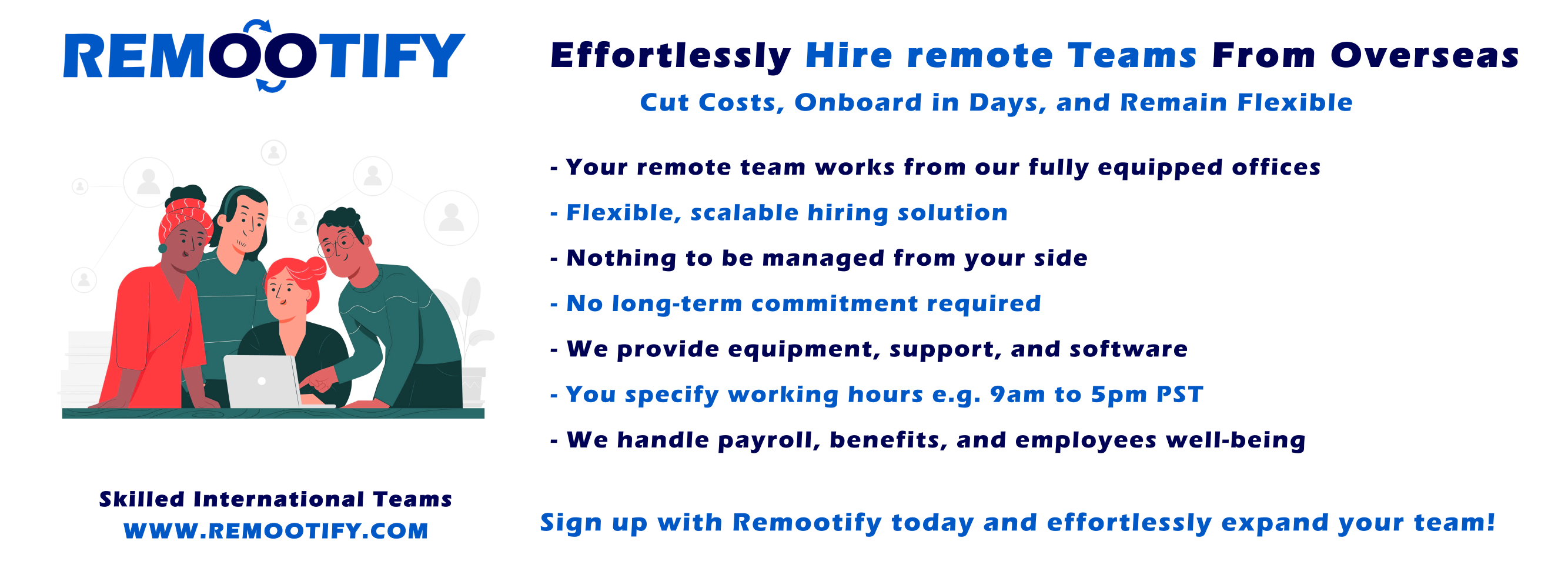Start hiring YOUR REMOTE TEAM, Today!
Enter your information below to start a discussion with one of our team members!

The rise of remote work has reshaped the modern work landscape, introducing both flexibility and challenges.
Amid this transformation, the vital link between mental health and remote work has become increasingly apparent.
This article delves into the intricate relationship between these two facets, highlighting the necessity of prioritizing mental health in remote work environments.
By unraveling this connection, we aim to foster healthier, more sustainable approaches to remote work that prioritize the well-being of individuals.
The Rise of Remote Work
In recent years, remote work has gained significant traction as a preferred mode of work for numerous individuals and organizations.
Several factors have contributed to the rapid rise of remote work:
- Technological Advancements: The proliferation of high-speed internet, cloud computing, and collaborative tools has made it feasible for individuals to work seamlessly from various locations.
- Global Connectivity: With the world becoming more interconnected, companies can tap into a global talent pool without being restricted by geographical boundaries.
- Changing Work Culture: Modern work culture emphasizes outcomes and results rather than physical presence, aligning well with remote work dynamics.
- Millennial and Gen Z Workforce: Younger generations prioritize flexibility and value experiences, making remote work an attractive proposition.
- Cost Efficiency: For both employees and employers, remote work can lead to reduced overhead costs related to office space and facilities.
- Work-Life Balance: Remote work offers a way to blend work responsibilities with personal life, contributing to improved work-life balance.
- Environmental Concerns: Organizations and individuals seeking to minimize their carbon footprint recognize remote work as a means to reduce commuting-related emissions.
- Pandemic Influence: The COVID-19 pandemic compelled many companies to adopt remote work as a safety measure, accelerating its adoption and acceptance.
- Productivity Focus: Remote work’s potential to enhance productivity by minimizing workplace distractions has driven its adoption across industries.
- Customized Workspaces: Individuals can tailor their work environment to suit their preferences, potentially boosting creativity and focus.
- Evolving Management Practices: Managers are adapting to leading remote teams, utilizing new strategies to ensure collaboration, communication, and performance.
- Flexible Hours: Remote work often allows for flexible scheduling, accommodating varying peak productivity times and personal commitments.
Challenges Posed by Remote Work to Mental Health
- Social Isolation and Loneliness
- Limited face-to-face interactions lead to feelings of isolation.
- Reduced opportunities for spontaneous conversations and team bonding.
- Importance of virtual social interactions to combat loneliness.
- Employers fostering virtual team-building activities.
- Blurring of Work-Life Boundaries
- Difficulty in distinguishing work time from personal time.
- Constant accessibility to work-related tasks leads to burnout.
- Importance of setting clear boundaries and sticking to a schedule.
- Utilizing tools that help signal the start and end of the workday.
- Increased Stress and Burnout
- Lack of physical separation between work and home environments.
- Pressure to always be available due to the remote nature of work.
- Importance of self-care practices and regular breaks.
- Employers promote work-life balance and discourage overworking.
- Communication and Collaboration Difficulties
- Reliance on digital communication tools can lead to misinterpretation.
- Time zone differences affect real-time collaboration.
- Importance of effective communication and clear expectations.
- Utilizing video calls to enhance nonverbal communication cues.
Essential Tips for Safeguarding Mental Health in Remote Work
I. Establishing a Healthy Routine
- Setting consistent work hours
- Establishing regular work hours creates structure and routine, promoting good mental health in remote work.
- Consistency prevents overworking and maintains a balance between work and personal life, fostering mental well-being.
- Incorporating breaks and physical activity
- Including short, frequent breaks in the workday supports mental health in remote work settings.
- Taking breaks for physical activity boosts mood, reduces stress, and enhances overall mental well-being.
- Creating a designated workspace
- Designating a specific workspace at home reinforces boundaries between work and personal life, benefiting mental health.
- Having a dedicated workspace helps in maintaining focus, minimizing distractions, and fostering a conducive work environment.
II. Fostering Social Connection and Communication
- Regular virtual check-ins
- Engaging in regular virtual check-ins with colleagues combats isolation, a common challenge for mental health in remote work.
- Video calls maintain social connections, reducing feelings of loneliness and promoting overall well-being.
- Engaging in morale virtual water cooler moments helps enhance mental health in remote work.
- Utilizing collaboration tools
- Leveraging communication tools and platforms facilitates teamwork and social interaction in remote work environments.
- Effective use of these tools helps maintain a sense of connection and contributes to positive mental health outcomes.
III. Prioritizing Self-Care
- Setting boundaries
- Defining clear boundaries between work and personal time is vital for mental health in remote work scenarios.
- Establishing limits prevents work-related stress from spilling over into personal life, ensuring better overall well-being.
- Taking regular breaks
- Making time for regular breaks, even in remote work, is essential for maintaining mental health.
- Breaks offer opportunities for relaxation, reducing stress, and promoting sustained cognitive performance.
- Practicing mindfulness and stress management
- Incorporating mindfulness practices and stress management techniques directly addresses mental health challenges in remote work.
- Mindfulness and relaxation exercises mitigate the negative impact of stress, fostering better mental resilience.
IV. Nurturing Work-Life Balance
- Creating a shutdown ritual
- Developing a shutdown routine at the end of the workday aids in separating work time from personal time, supporting mental health.
- Engaging in such rituals helps prevent overthinking about work, contributing to a more balanced mental state.
- Engaging in non-work activities
- Pursuing hobbies and spending time on non-work activities promotes mental health during remote work.
- Balancing work with personal interests provides a necessary break, contributing to improved overall well-being.
- Taking vacation time
- Utilizing vacation time is crucial for mental health in remote work situations.
- Taking breaks from work responsibilities, even when working remotely, rejuvenates the mind and prevents burnout.
V. Defining Clear Boundaries
- Communicating availability to colleagues
- Openly discussing your working hours and response times with colleagues promotes stronger mental health in remote work scenarios.
- Transparent communication sets expectations, reducing potential work-related anxieties and contributing to overall well-being.
- Disconnecting after work hours
- Actively disconnecting from work-related communication and tasks after work hours is essential for mental health in remote work.
- Establishing clear boundaries prevents remote work from negatively impacting personal time and mental rejuvenation.
- Avoiding multitasking and overworking
- Prioritizing single-tasking over multitasking reduces cognitive strain and supports better mental health outcomes in remote work.
- Avoiding overworking by setting realistic limits on tasks and hours contributes to sustained productivity and overall well-being.
VI. Prioritizing Social Connection
- Regular virtual check-ins with colleagues
- Engaging in consistent virtual check-ins with colleagues is crucial for maintaining positive mental health in remote work environments.
- These interactions provide a sense of connection, reducing feelings of isolation and fostering a supportive work community.
- Engaging in online communities and forums
- Participating in online professional or interest-based communities contributes to mental well-being in remote work settings.
- Connecting with like-minded individuals helps alleviate isolation, enhancing overall mental health through shared experiences.
- Scheduling virtual social activities
- Actively scheduling virtual social activities with coworkers or friends supports mental health in remote work situations.
- Virtual socializing reduces feelings of loneliness, promoting a sense of belonging and positively impacting overall well-being.
VII. Open Communication with Employers
- Discussing workload and expectations
- Engaging in open conversations with employers about workload and expectations is crucial for maintaining good mental health in remote work.
- Clear communication ensures that workloads are manageable, reducing stress and promoting a positive work environment.
- Raising concerns about mental health without stigma
- Creating an environment where employees can openly discuss mental health concerns is essential for remote work settings.
- Addressing mental health challenges without fear of stigma encourages early support-seeking and contributes to overall well-being.
- Exploring flexible work arrangements
- Conversations about flexible work arrangements with employers are integral for promoting mental health in remote work scenarios.
- Tailoring work hours or conditions to individual needs enhances work-life balance and positively impacts mental well-being.
Taking Care Of Your Mental Health
—
Conclusion
In summary, the surge in remote work highlights the crucial link between mental health and this trend. Prioritizing well-being through routine, social interaction, self-care, and communication is essential for a balanced remote work experience. Thus, mental health in remote work can be effectively navigated.
—
FAQs
How does remote work impact mental health?
Remote work can lead to challenges such as social isolation, blurred work-life boundaries, increased stress, and communication difficulties, all of which can negatively affect mental health.
What strategies can help maintain mental health in remote work?
Establishing a consistent routine, creating a designated workspace, taking regular breaks, engaging in virtual social interactions, practicing self-care, and setting clear boundaries between work and personal life are essential strategies.
How can employers contribute to remote workers’ mental health?
Employers can foster virtual team-building activities, encourage open communication about workload and expectations, promote work-life balance, and provide resources for stress management and well-being.
Can remote work positively impact mental health?
Yes, with proper strategies in place, remote work can offer benefits such as increased flexibility, reduced commute-related stress, and the ability to tailor work environments, which can contribute to improved mental well-being.





